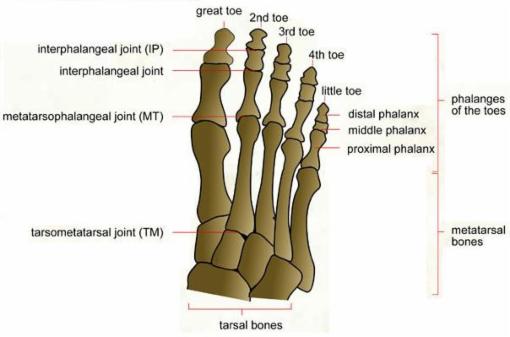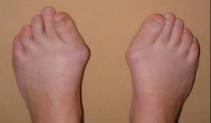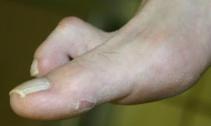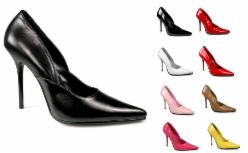These pages offer advice only. They are not a substitute for a proper consultation.
The Forefoot- Great Toe
This is the last part of the foot to leave the ground as we walk or run. A powerful muscle inside the foot locks the metatarophalangeal joint straight (see picture below) so that the equally powerful muscle in the calf can pull the end of the toe down at the interphalangeal joint. This provides the push-off, or 'spring in the step'. This function can fail for a number of reasons.
Bones of the foot

Sometimes the first metatarsal spreads out, pushing both itself and the big toe against the inside of the shoe. The big toe is pushed inwards and a 'bunion' results. In itself this can be painful. However, this 'hallux valgus' also causes the main tendon to 'bow string', which increases the deformity further and also reduces the power of the tendon and thus the ability to 'push off'. The foot's response is to pull harder on the second toe, which deforms over time into a 'hammer toe'.
 Bunions
Bunions
Hammer Toe 
Another problem that occurs is osteoarthrosis of the 1st MTP joint, or 'Hallux Rigidus'. This occurs because the joint stiffens and becomes sore. Painful lumps form around the joint (osteophytes) and these rub on the shoes, causing the condition to worsen. Early on in the condition, pain only really increases during excercise, but as the joint fails inflammation increases and so does the pain.
Both of these conditions are worsened considerably by tight shoes and higher heels, so generally women suffer more than men. Adapting to more sustainable shoewear is essential if failure of function is to be avoided.
 Try to avoid tight, high-heeled footware
Try to avoid tight, high-heeled footware
Weakening of the foot muscles from nerve or muscle problems causes the arch of the foot to rise and creates a loss of straightening of the 1st MTP joint before 'push-off'. This leads to a buckling of the joints of the great toe and 'clawing' as the long muscle of the calf exerts its strong pull. Clawing of the great toe causes rubbing on the shoes and an increase in pressure under the metatarsal head. A similar condition often affects the lesser toes at the same time.